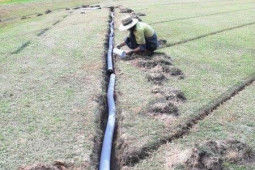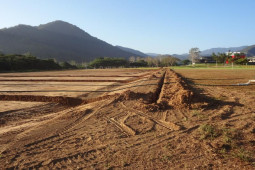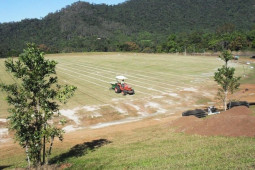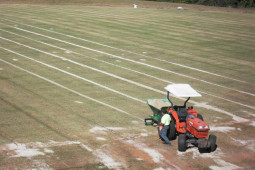Building and turfing sports fields
At Australian Turf Management, we specialise in building quality playing and sports fields in and around the Cairns and north Queensland areas.
But, it’s important to note that not all sports surfaces are the same; for example, quick healing grass varieties are more suitable for fast ball games, while more drought tolerant types are great for cricket pitches.
That’s why we’ll take your requirements and usage needs into account before planning, constructing and turfing your playing field, from initial site works to drainage and wind factor considerations.
It’s this commitment to your playing field’s longevity, usability and ease of maintenance that has led our success in constructing both the rugby league field at St Andrews College and the Cec Anderson Oval in Innisfail
Drainage
Whether it's a professional sports field, open grass field or your lawn area at home, water logged turf will spoil its aesthetics and usabilty.
Every location is different and has different drainage needs to ensure a great playing surface whether for the kids in the backyard or for the big game on Saturday. We have the experience and equipment to offer drainage solutions for any grassed area, big or small, we will work through the most cost-effective way to manage your waterlogged or soggy surfaces. We'll also take into account typical rainfall and the natural slope of the field.
One common solution is slit drainage, where we run shallow trenches of slitted pipe and backfill with a water permeable material that will capture, divert and move water from the surface. Consideration of the type of backfill material is important; certain types of sand or gravel are the most effective.
Slit drainage
Perfect for very large areas of turf or sports fields, slit drainage is the most cost-effective way to manage waterlogged or soggy surfaces. They are created using machinery that cuts long narrow trenches into the grass surface; the number of slits needed depends on a number of factors, including location, typical rainfall and whether there is a natural slope on the land.
Each trench is then backfilled with a water permeable material that will capture, divert and move water from the surface to a predestined position, usually the end of the playing field where there is a storm water drain. Consideration of the type of backfill material is important; certain types of sand or gravel are the most effective, and will still give your playing or event surface an even and clean finish.
Alternatively, we can also use pipes in the trenches that will divert water much faster than natural seepage through backfill material.
For our drainage recommendations or to get an obligation free quote, we're happy to come to you, give our friendly team a call today!







